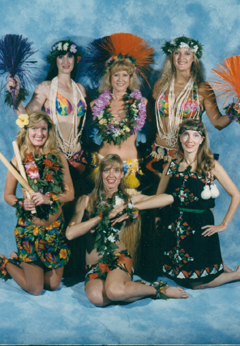History of Hula Dancing - From Worship to Tourism
Hula dancing is known to the world as a dance done to guitar and ukelele music, on the beaches of Hawaii, by beautiful Hawaiian girls in grass skirts wearing leis. The general conjecture seems to be that the dance is done mostly to "honor" the tourist. While hula is performed at resorts all over Hawaii, this is not how the dance began or was performed for hundreds of years. There were no guitars. No ukeleles. No grass skirts. No tourists. There was only ha'a (the original name of the dance), Laka and Pele.
Hula has its origins in ancient history as a ritual dance performed for the Volcano goddess, Pele. It is said that her sister, Hi'iaka originally performed the dance for Pele. The goddess Laka is the keeper of the dance. She was honored with prayers, offerings and leis which were given by the dancers. Laka is the goddess most often referred to when it comes to modern Hula dancing. The history is an oral one and variations of the ancient myth exist. In fact, a "mele" (see below) is often performed that describes the story of Hi'aka and Pele.
When the dance began, it was done to poetic chants performed by men. The chant was called the Mele. The men relayed the poetry and the female dancers played it out in expressive form. Instruments used were sharkskin drums, rattles, gourds and castanets. Costumes were not made of grass. Women wore wrapped skirts made of cloth and men wore loincloths. Leis, bracelets, and necklaces were worn then as they are now. Leis were not meant to be worn after a ritual dance. They were placed on the altar of Laka as an offering of flowers to the goddess. Hula was more than a ritual dance. It was the Hawaiian's way of keeping a record of history. Much of the history was lost after it was banned in the early part of the 19th century.
Originally, the hula was called the "Ha`a". The name was changed to "Hula" in the l9th century. In 1820, Christian missionaries arrived in Hawaii and converted many of the people to the Christian religion. When Queen Ka'ahumanu became a Christian, she had the temples (Heiaus) and goddess images destroyed. Hula was banned as it was a pagan ritual dance with moves the missionaries saw as vulgar, disgusting and sinful. It was taught and performed only in secret for a while. King Kamehameaha III re-established Hula by default in the 1830's when he insisted on religious freedom. Unable to suppress the Hula completely, the missionaries then insisted that it only be done wearing high-neck gowns with long sleeves.
The last king of Hawaii, David Kalakaua, whose reign lasted from 1874 to 1891, brought it out into the open encouraging not only its performance but adding moves, costumes, text and songs. Known as the Merry Monarch, King Kalakaua loved to travel amongst the people and enjoyed festivals. Hula was part of the festivals and celebrations and was often danced in his honor. Early in the 20th century, prayers, rituals and training were still a major part of the Hula dance.
Hollywood took the Hula and portrayed it in a much different manner. By the mid 20th century, hula was becoming more commercialized and new instruments were added such as the guitar and ukelele. In the 1970's, Hawaii underwent a "hula revolution", and nterest in the traditional dance was renewed. The ancient culture began to emerge after decades of subversion and exploitation by tourism and media entertainment. There are two main types of Hula performed today: the hula kahiko (ancient) and the hula auana (modern). While the modern dance is beautiful, the ancient dance leaves a pounding in your heart and a whisper in your soul.
Though modern influence has touched Hula dancing, it still remains a beautiful dance to watch or perform. The intricacies of hula dancing involve the hands, eyes, hips and legs. It is with the hands that the story is described. The eyes give expression to the story. The movements of the feet and the undulations of the hips speak of rhythm and power. Its ancient roots can be seen in the movements that symbolize nature with all its contrasts - from the gentle swaying of the palms to the wildly exploding dances of war.
Source: HulaDanceHQ
